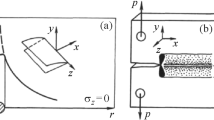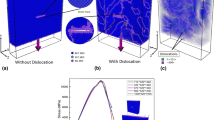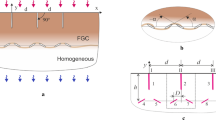Abstract
The temperature-dependent fracture toughness of a brittle coating/ductile substrate system, WC-10Co4Cr deposited on 1018 low carbon steel, is evaluated at microscopic level using an indentation-based model in terms of the Arrhenius-type equation and rate-controlling theory. The formulation of the model utilizes the parameters of crystal structures of each phase in the coating material. The slip systems of hard hexagonal \( \updelta \)-WC phase and soft FCC \( \upalpha \)-Co phase are analyzed. The fracture toughness of the two-phase coating is obtained by integrating the fracture toughness of single \( \updelta \)-WC phase coating and that of single \( \upalpha \)-Co phase coating using either the basic mixture method or the unconstrained mixture method. The results suggest that the fracture toughness of WC-10Co4Cr coating/1018 low carbon steel substrate system may remain constant until the temperature reaches a critical value, about 200 K, and ranges from 2.16 to 10.82 \( {\text{MPa}}\;{\text{m}}^{1/2} \), with temperature increasing from room temperature (298 K) to 1000 K.

















Similar content being viewed by others
References
X.K. Zhu and J.A. Joyce, Review of Fracture Toughness (G, K, J, CTOD, CTOA) Testing and Standardization, Eng. Frac. Mech., 2012, 85, p 1-46
B.R. Lawn, A.G. Evans, and D.B. Marshall, Elastic/Plastic Indentation Damage in Ceramics: The Median/Radial Crack System, J. Am. Ceram. Soc., 1980, 63(9–10), p 574-581
K. Niihara, A Fracture Mechanics Analysis of Indentation-Induced Palmqvist Crack in Ceramics, J. Mater. Sci. Lett., 1983, 2, p 221-223
S. Smith and R. Scattergood, Crack-Shape Effects for Indentation Fracture Toughness Measurements, J. Am. Ceram. Soc., 1992, 75(2), p 305-315
B.D. Beake, M. Garcia, and J.F. Smith, Micro-Impact Testing: A New Technique for Investigating Fracture Toughness, Thin Solid Films, 2001, 398–399, p 438-443
X. Wang, C.J. Wang, and A. Atkinson, Interface Fracture Toughness in Thermal Barrier Coatings by Cross-Sectional Indentation, Acta Mater., 2012, 60, p 6152-6163
N.H. Faisal, J.A. Steel, R. Ahmed, and R.L. Reuben, The Use of Acoustic Emission to Characterize Fracture Behavior during Vickers Indentation of HVOF Thermally Sprayed WC-Co Coatings, J. Therm. Spray Technol., 2009, 18(4), p 525-535
S. Houdkova and M. Kasparova, Experimental Study of Indentation Fracture Toughness in HVOF Sprayed Hardmetal Coatings, Eng. Frac. Mech., 2013, 110, p 468-476
B. Bozzini and M. Boniardi, A Model for the Evaluation of Indentation Crack Arrest Fracture Toughness of Supported Films, J. Mater. Sci., 2001, 36, p 511-518
D. Chicot, G. Duarte, A. Tricoteaux, B. Jorgowski, A. Leriche, and J. Lesage, Vickers Indentation Fracture (VIF) Modeling to Analyze Multi-Cracking Toughness of Titania, Alumina and Zirconia Plasma Sprayed Coatings, Mater. Sci. Eng. A, 2009, 527, p 65-76
A. Roman, D. Chicot, and J. Lesage, Indentation Tests to Determine the Fracture Toughness of Nickel Phosphorus, Surf. Coat. Technol., 2002, 155, p 161-168
E. Amar and A. Pineau, Interpretation of Ductile Fracture Toughness Temperature Dependence of a Low Strength Steel in Terms of a Local Approach, Eng. Frac. Mech., 1985, 22(6), p 1061-1071
B.Z. Margolin, A.G. Gulenko, V.A. Nikolaev, and L.N. Ryadkov, A New Engineering Method for Prediction of the Fracture Toughness Temperature Dependence for RPV Steels, Int. J. Press. Vess. Pip., 2003, 80(12), p 817-829
T. Smida, J. Babjak, and I. Dlouhy, Prediction of Fracture Toughness Dependence from Tensile Test Parameters, Metall. Mater., 2010, 48(6), p 354-361
G. Qian, T. Nakamura, C.C. Berndt, and S.H. Leigh, Tensile Toughness Test and High Temperature Fracture Analysis of Thermal Barrier Coatings, Acta Mater., 1997, 45(4), p 1767-1784
D. Wu and Y.C. Zhou, Interface Fracture Toughness of TBCs at High Temperature. Proceedings of the 11th International Conference on Fracture, Turin, Italy, 2005, p 1976-1981
M. Watanabe, T. Okabe, A. Enoki, and T. Kishi, Evaluation of in situ Fracture Toughness of Ceramic Coatings at Elevated Temperature by AE Inverse Analysis, Sci. Technol. Adv. Mater., 2003, 4(2), p 205-212
L.M. Berger, P. Ettmayer, P. Vuoristo, T. Mäntylä, and W. Kunert, Microstructure and Properties of WC-10%Co-4%Cr Spray Powders and Coatings: Part 1. Powder Characterization, J. Therm. Spray Technol., 2001, 10, p 311-325
M. Yandouzi, L. Ajdelsztajn, and B. Jodoin, WC-Based Composite Coatings Prepared by the Pulsed Gas Dynamic Spraying Process: Effect of the Feedstock Powders, Surf. Coat. Technol., 2008, 202, p 3866-3877
A.S. Kurlov and A.I. Gusev, Tungsten Carbides and W-C Phase Diagram, Inorgan. Mater., 2006, 42, p 121-127
A.S. Kurlov and A.I. Gusev, Phases and Equilibria in the W-C and W-Co-C Systems, Properties and Application in Hardmetals, Springer Series in Materials Science, Vol 184, Springer International Publishing, Switzerland, 2013, p 5-56
K. Ishida and T. Nishizawa, The Co-Cr (Cobalt-Chromium) System, Bull. Alloy Phase Diag., 1990, 11, p 357-370
S. Hong, Y. Wu, Y. Zheng, B. Wang, W. Gao, and J. Lin, Microstructure and Electrochemical Properties of Nanostructured WC-10Co-4Cr Coating Prepared by HVOF Spraying, Surf. Coat. Technol., 2013, 235, p 582-588
D. Mari, B. Clausen, M.A.M. Bourke, and K. Buss, Measurement of Residual Thermal Stress in WC-Co by Neutron Diffraction, Int. J. Refrac. Metal. Hard Mater., 2009, 27, p 282-287
B.H. Kim and D.S. Suhr, Characteristics of HVOF-Sprayed WC-Co Cermet Coatings Affected by WC Particle Size and Fuel/Oxygen Ratio, Mater. Trans., 2001, 42(5), p 833-837
X.J. Liu, R. Kainuma, I. Ohnuma, K. Ishida, and K. Oikawa, The Use of Phase Diagrams and Thermodynamic Databases for Electronic Materials, JOM, 2003, 55, p 53-59
G.J. Dickins, A.M.B. Douglas, and W.H. Taylor, The Crystal Structure of the Co-Cr σ Phase, Acta Crystall., 1956, 9, p 297-303
J.D. Bolton and M. Redington, Plastic Deformation Mechanisms in Tungsten Carbide, J. Mater. Sci., 1980, 15, p 3150-3156
V. Jayaram, Plastic Incompatibility and Crack Nucleation during Deformation on Four Independent Slip Systems in Tungsten Carbide-Cobalt, Acta Metall., 1987, 35, p 1307-1315
S.B. Luyckx, Slip System of Tungsten Carbide Crystals at Room Temperature, Acta Metall., 1970, 18, p 233-236
M.K. Hibbs and R. Sinclair, Room-Temperature Deformation Mechanisms and the Defect Structure of Tungsten Carbide, Acta Metall., 1981, 29, p 1645-1654
M. Bľanda, A. Duszová, T. Csanádi, P. Hvizdoš, F. Lofaj, and J. Dusza, Indentation Fatigue of WC Grains in WC-Co Composite, J. Eur. Ceram. Soc., 2014, 34, p 3407-3412
R. Bauer, E.A. Jägle, W. Baumann, and E.J. Mittemeijer, Kinetics of the Allotropic hcp–fcc Phase Transformation in Cobalt, Philos. Mag., 2011, 91, p 435-457
H. Wei and Y. Wei, Interaction between a Screw Dislocation and Stacking Faults in fcc Metals, Mater. Sci. Eng. A, 2012, 541, p 38-44
M.M. Myshlyaev, Intersection of Screw Dislocations in fcc Crystals during Torsional Deformation, Doklady Phys., 2012, 57, p 107-109
W.A. Jesser and J.W. Matthews, Growth of F.C.C. Cobalt on Nickel, Acta Metall., 1968, 16, p 1307-1311
G.R. Irwin and J.W. Matthews, Analysis of Stresses and Strains near the End of a Crack Traversing a Plate, J. Appl. Mech., 1957, 24, p 361-364
J.R. Rice, A Path Independent Integral and the Approximate Analysis of Strain Concentration by Notches and Cracks, J. Appl. Mech., 1968, 35, p 379-386
Q. Wei, S. Cheng, K.T. Ramesh, and E. Ma, Effect of Nanocrystalline and Ultrafine Grain Sizes on the Strain Rate Sensitivity and Activation Volume: fcc Versus bcc Metals, Mater. Sci. Eng. A, 2004, 381, p 71-79
K.S. Chan, Relationships of Fracture Toughness and Dislocation Mobility in Intermetallics, Metall. Mater. Trans. A, 2003, 34(10), p 2315-2328
P.J. Burnett and D.S. Rickerby, The Mechanical Properties of Wear-Resistant Coatings: I: Modelling of Hardness Behavior, Thin Solid Films, 1987, 148, p 41-50
R.F. Cook and G.M. Pharr, Direct Observation and Analysis of Indentation Cracking in Glasses and Ceramics, J. Am. Ceram. Soc., 1990, 73, p 787-817
N.V. Demidova, X.J. Wu, and R. Liu, A Fracture Toughness Model for Brittle Coating on Ductile Substrate under Indentation Loading, Eng. Frac. Mech., 2012, 82, p 17-28
K. Durst, B. Backes, and M. Göken, Indentation Size Effect in Metallic Materials: Correcting for the Size of the Plastic Zone, Scr. Mater., 2005, 52, p 1093-1097
S. Lay, J.L. Chermant, and J. Vicens, Plasticity of WC Materials by T.E.M. Investigations, Deformation of Ceramic Materials II., Vol 18, R.E. Tressler and R.C. Bradt, Eds., Springer, USA, 1984, p 87-96
M. Freels, P.K. Liaw, L. Jiang, and D.L. Klarstrom, Cobalt Alloys and Composites, Advanced Structural Materials: Properties, Design Optimization, and Applications, W.O. Soboyejo and T.S. Srivatsan, Eds., CRC Press, Boca Raton, 2007, p 187-224
H.W. Hugosson, O. Eriksson, U. Jansson, A.V. Ruban, P. Souvatzis, and I.A. Abrikosov, Surface Energies and Work Functions of the Transition Metal Carbides, Surf. Sci., 2004, 557, p 243-254
M. Alden, S. Mirbt, H.L. Skriver, N.M. Rosengaard, and B. Johansson, Surface Magnetism in Iron, Cobalt, and Nickel, Phys. Rev. B, 1992, 46, p 6303-6312
K.S. Chan, Alloying Effects on Fracture Mechanisms in Nb-Based Intermetallic in-Situ Composites, Mater. Sci. Eng. A, 2002, 329–331, p 513-522
F.L. Zhang, C.Y. Wang, and M. Zhu, Nanostructured WC/Co Composite Powder Prepared by High Energy Ball Milling, Scr. Mater., 2003, 49, p 1123-1128
T. Ungár, A. Borbély, G.R. Goren-Muginstein, S. Berger, and A.R. Rosen, Particle-Size, Size Distribution and Dislocations in Nanocrystalline Tungsten-Carbide, Nanostruct. Mater., 1999, 11, p 103-113
K.S. Chan and D.L. Davidson, Delineating Brittle-Phase Embrittlement and Ductile-Phase Toughening in Nb-Based in-Situ Composites, Metall. Mater. Trans. A, 2001, 32(11), p 2717-2727
A.F. Bower and M. Ortiz, A Three-Dimensional Analysis of Crack Trapping and Bridging by Tough Particles, J. Mech. Phys. Solids, 1991, 39(6), p 815-858
J.R. Pickens and J. Gurland, The Fracture Toughness of WC-Co Alloys Measured on Single-Edge Notched Beam Specimens Precracked by Electron Discharge Machining, Mater. Sci. Eng., 1978, 33, p 135-142
S.R. Lampman, N. Dimatteo, and ASM International. Handbook Committee, Fracture Mechanics, Damage Tolerance, and Life Assessment, Fatigue and Fracture, Vol 19, ASM International, USA, 1996, p 911-1475
E.L. Cantera and B.G. Mellor, Fracture Toughness and Crack Morphologies in Eroded WC-Co-Cr Thermally Sprayed Coatings, Mater. Lett., 1998, 37, p 201-210
R.J.K. Wood, Tribology of Thermal Sprayed WC–Co Coatings, Inter. J. Refrac. Metal. Hard Mater., 2010, 28, p 82-94
A. Karimpoor, High Strength Nanocrystalline Cobalt with High Tensile Ductility, Scr. Mater., 2003, 49, p 651-656
P. Chivavibul, M. Watanabe, S. Kuroda, J. Kawakita, M. Komatsu, K. Sato, and J. Kitamura, Effect of Powder Characteristics on Properties of Warm-Sprayed WC-Co Coatings, J. Therm. Spray Technol., 2009, 19, p 81-88
D.J. Siegel, L.G. Hector, Jr., and J.B. Adams, Adhesion, Stability, and Bonding at Metal/Metal-Carbide Interfaces: Al/WC, Surf. Sci., 2002, 498, p 321-336
A.A. Gnidenko, First Principle Simulation of the Co Layers Behavior on a Surface of Hexagonal Tungsten Carbide, Phys. Procedia, 2012, 23, p 132-135
Acknowledgment
The authors are grateful for the financial support from Natural Science and Engineering Research Council of Canada (NSERC), the in-kind support from National Research Council Canada (NRC) and both financial and in-kind support from Kennametal Satellite Inc.
Author information
Authors and Affiliations
Corresponding author
Rights and permissions
About this article
Cite this article
Gu, Y., Chen, K., Liu, R. et al. Crystal-Structure-Based Modeling Study of Temperature-Dependent Fracture Toughness for Brittle Coating Deposited on Ductile Substrate. J Therm Spray Tech 25, 1344–1356 (2016). https://doi.org/10.1007/s11666-016-0452-2
Received:
Revised:
Published:
Issue Date:
DOI: https://doi.org/10.1007/s11666-016-0452-2




